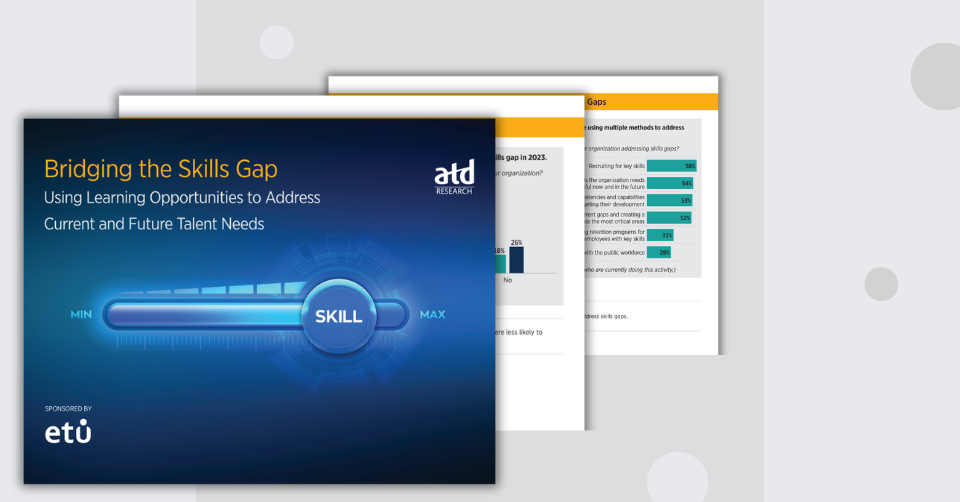4 strategies to upskill your hybrid team effectively

Remember the days when the word “hybrid” related to cars that could run on electricity or gasoline?
Now, this word is part of our everyday business lexicon, with a greater focus on how organizations can successfully navigate the new work reality.
Many businesses are continuing their hybrid working models, where employees work from home a certain number of days and go into the brick-and-mortar buildings other days.
Rolling out learning and development initiatives can be challenging when all workers are in different locations or have limited time when they are together in the office.
At the same time, data has continued to show the importance of upskilling. According to a LinkedIn report, 82% of L&D professionals agree that engaged learners are more likely to find new roles in their organization, and, as they discover new positions, they will participate more in internal mobility programs. In the same report, 66% of L&D professionals from around the world agree that they're focused on rebuilding and reshaping their organizations.
From this data, it's crystal clear that upskilling hybrid teams will continue to be a major goal for companies looking to support and retain top talent.
The bottom line? The business world has changed radically and in the new hybrid future, where critical skills are in short supply, organizations who are creative and adopt new strategies will be the ones who succeed.
They need to learn how to implement effective hybrid upskilling solutions fast. The absence of such corporate learning solutions, will lead to unengaged workers, which in today’s tight labor market, could mean further resignations.
Here are 4 strategies to ensure organizations can upskill their hybrid team effectively:
1) Focus on skills not knowledge.
CLOs, HR professionals and Talent Management departments need to focus more on skills rather than knowledge, in order to re-align their thinking and approach to address the new normal of workplaces.
The best way to make the most impact is to identify work scenarios where there's a struggle or disconnect within the organization. Those tasked with sourcing and rolling out corporate learning need to ensure that L&D is aligned to business goals.
To improve L&D effectively, there should be a needs assessment that's thorough and consistent -- one that would clearly point out which skills your hybrid teams need to improve for the betterment of your organization.
This is where simulation learning makes the most sense. Customized, realistic situations in immersive environments allow real skill development, creating “aha moments” for employees.
Placing remote learners in life-like situations that "feel" like today’s hybrid workplace helps cement the knowledge into their memory, draws an emotional connection, and goes beyond traditional eLearning. My last blog discussed how eLearning can kill an organization when delivered ineffectively.
Simulation learning offers realistic workplace skills assessment that’s accurate and data-rich -- and allows for engaging training after the assessment is complete. However, its effectiveness will depend on the partner you use. That's why it's essential to find the right ally to help create an immersive learning curriculum that is tailored to an organization's identified skills gaps.
2) Make sure that you and your hybrid workers are aligned.
No matter which type of immersive learning you prefer, it may not be as effective if your hybrid workers don't clearly understand what it's for. Pre-communication and related company messaging is critical. Employees need to know what's expected of them to take full advantage of the many immersive learning benefits.
As a business leader, you need to be aligned with your workforce so there can be synergy within the organization. Remember what’s at stake – the consequences if employees aren't being upskilled effectively. Some of these consequences include losing clients and employees (as we've seen lately with the Great Resignation), and a significant decline in productivity.
It's also important to show your team that immersive learning works. One such way is to acquire testimonies from those who've already done the simulations and show that it has helped improve their performance, leading to increased productivity and better career possibilities.
3) Take advantage of the data.
Next, it is vital to analyze the data gathered from your immersive learning initiatives. The information and analytics that come with simulations will tell you about your workforce’s skill strengths and gaps, and what the focus should be moving forward.
Along with this, the use of pre-assessments, allowing employees to test out of a simulation if they are sufficiently knowledgeable on the subject, also respects the employee's time and saves resources. Both analytics and pre-assessments will pave the way for seat-time savings and better quality training content in the future.
For L&D and talent leaders, data also plays a significant role. Skills are the new currency -- utilizing the analytics from simulations provides a vast amount of data beyond surface completions, and builds a verified skill profile of an employee. This delivers a vital avenue of growth and enables you to become a stronger executive partner. When L&D & HR leaders arrive at the table with data and a deeper level of insight, it makes everyone pay attention.
4) Learn from feedback.
While the value of data is difficult to understate, it's important to remember not to rely on skill data alone. It would be best if you also tried to gather feedback from your hybrid workforce directly, before and after the training. Ask them about what they learned and how this method of learning made them feel.
While the business needs will be the center of your decision-making when it comes to training, employees are the driving force. Leadership must listen to what they want and how they want to learn. Surveys, focus groups, and one-on-one meetings with managers should be utilized to gather this information.
Today, there is more emphasis on developing skills than knowledge-based training alone, and upskilling thousands of hybrid corporate learners at scale is more accessible with immersive simulation learning.
Organizations need to adapt and go beyond what's on the surface to engage employees in real-life scenarios, which will, in turn, significantly grow and scale the talent in the company.

